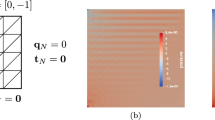Abstract
This paper proposes a new numerical method for a fully-coupled, quasi-static thermo-poroelasticity model in a unified enriched Galerkin (EG) method framework. In our method, the mechanics sub-problem is solved using a locking-free EG method, and the flow and heat sub-problems are solved using a locally-conservative EG method. The proposed method offers mass and energy conservation properties with much lower costs than other methods with the same properties, including discontinuous Galerkin methods and mixed finite element methods. The well-posedness and optimal a priori error estimates are carefully derived. Several numerical tests confirm the theoretical optimal convergence rates and the mass and energy conservation properties of the new method.











Similar content being viewed by others
References
Biot, M.: Thermoelasticity and irreversible thermodynamics. J. Appl. Phys. 27(3), 240–253 (1956)
Biot, M.: General theory of three-dimensional consolidation. J. Appl. Phys. 12(2), 155–164 (1941)
Pandey, S., Vishal, V., Chaudhuri, A.: Geothermal reservoir modeling in a coupled thermo-hydro-mechanical-chemical approach: a review. Earth Sci. Rev. 185, 1157–1169 (2018)
Settgast, R.R., Fu, P., Walsh, S.D., White, J.A., Annavarapu, C., Ryerson, F.J.: A fully coupled method for massively parallel simulation of hydraulically driven fractures in 3-dimensions. Int. J. Numer. Anal. Methods. Geomech. 41(5), 627–653 (2017)
Williams, M.D., Vermeul, V.R., Reimus, P., Newell, D., Watson, T.B.: Development of models to simulate tracer behavior in enhanced geothermal systems. Technical report, Pacific Northwest National Lab. (PNNL), Richland, WA (United States) (2010)
Pruess, K.: The tough codes a family of simulation tools for multiphase flow and transport processes in permeable media. Vadose Zone J. 3(3), 738–746 (2004)
Zyvoloski, G.: Finite element methods for geothermal reservoir simulation. Int. J. Numer. Anal. Methods. Geomech. 7(1), 75–86 (1983)
Al-Khoury, R., Bonnier, P., Brinkgreve, R.: Efficient finite element formulation for geothermal heating systems. Part I: steady state. Int. J. Numer. Methods Eng. 63(7), 988–1013 (2005)
Zhang, J., Rui, H.: Galerkin method for the fully coupled quasi-static thermo-poroelastic problem. Comput. Math. Appl. 118, 95–109 (2022)
Xia, Y., Podgorney, R., Huang, H.: Assessment of a hybrid continuous/discontinuous Galerkin finite element code for geothermal reservoir simulations. Rock Mech. Rock Eng. 50(3), 719–732 (2017)
Einstein, H., Vecchiarelli, A.: Further development and application of geofrac-flow to a geothermal reservoir. Technical report, Massachusetts Inst. of Technology (MIT), Cambridge, MA (United States) (2014)
Brun, M.K., Ahmed, E., Nordbotten, J.M., Radu, F.A.: Well-posedness of the fully coupled quasi-static thermo-poroelastic equations with nonlinear convective transport. J. Math. Anal. Appl. 471(1), 239–266 (2019)
Sun, S., Liu, J.: A locally conservative finite element method based on piecewise constant enrichment of the continuous Galerkin method. SIAM J. Sci. Comput. 31(4), 2528–2548 (2009)
Lee, S., Lee, Y.-J., Wheeler, M.F.: A locally conservative enriched Galerkin approximation and efficient solver for elliptic and parabolic problems. SIAM J. Sci. Comput. 38(3), 1404–1429 (2016)
Lee, S., Wheeler, M.F.: Adaptive enriched Galerkin methods for miscible displacement problems with entropy residual stabilization. J. Comput. Phys. 331, 19–37 (2017)
Lee, S., Wheeler, M.F.: Enriched Galerkin methods for two-phase flow in porous media with capillary pressure. J. Comput. Phys. 367, 65–86 (2018)
Choo, J., Lee, S.: Enriched Galerkin finite elements for coupled poromechanics with local mass conservation. Comput. Methods Appl. Mech. Eng. 341, 311–332 (2018)
Yi, S.-Y., Lee, S., Zikatanov, L.: Locking-free enriched Galerkin method for linear elasticity. SIAM J. Numer. Anal. 60(1), 52–75 (2022)
Yi, S.-Y., Hu, X., Lee, S., Adler, J.H.: An enriched Galerkin method for the Stokes equations. Comput. Math. Appl. 120, 115–131 (2022)
Lee, S., Yi, S.-Y.: Locking-free and locally-conservative enriched Galerkin method for poroelasticity. J. Sci. Comput. 94, 26 (2023). https://doi.org/10.1007/s10915-022-02079-0
Zimmerman, R.: Coupling in poroelasticity and thermoelasticity. Int. J. Rock Mech. Min. Sci. 37(1–2), 79–87 (2000)
Cacace, M., Jacquey, A.B.: Flexible parallel implicit modelling of coupled thermal-hydraulic-mechanical processes in fractured rocks. Solid Earth 8(5), 921–941 (2017)
Arndt, D., Bangerth, W., Davydov, D., Heister, T., Heltai, L., Kronbichler, M., Maier, M., Pelteret, J.-P., Turcksin, B., Wells, D.: The deal.II library, version 8.5. J. Numer. Math. 81, 407–422 (2017)
Acknowledgements
The work of S.-Y. Yi was partially supported by the U.S. National Science Foundation under Grant DMS-2208426 and by the U.S. Department of Energy, Office of Science, Energy Earthshots Initiatives under Award Number DE-SC-0024703. The work of S. Lee was partially supported by the U.S. National Science Foundation Grant DMS-2208402 and by the U.S. Department of Energy, Office of Science, Energy Earthshots Initiatives under Award Number DE-SC-0024703.
Author information
Authors and Affiliations
Corresponding author
Additional information
Publisher's Note
Springer Nature remains neutral with regard to jurisdictional claims in published maps and institutional affiliations.
Rights and permissions
Springer Nature or its licensor (e.g. a society or other partner) holds exclusive rights to this article under a publishing agreement with the author(s) or other rightsholder(s); author self-archiving of the accepted manuscript version of this article is solely governed by the terms of such publishing agreement and applicable law.
About this article
Cite this article
Yi, SY., Lee, S. Physics-preserving enriched Galerkin method for a fully-coupled thermo-poroelasticity model. Numer. Math. (2024). https://doi.org/10.1007/s00211-024-01406-x
Received:
Revised:
Accepted:
Published:
DOI: https://doi.org/10.1007/s00211-024-01406-x




